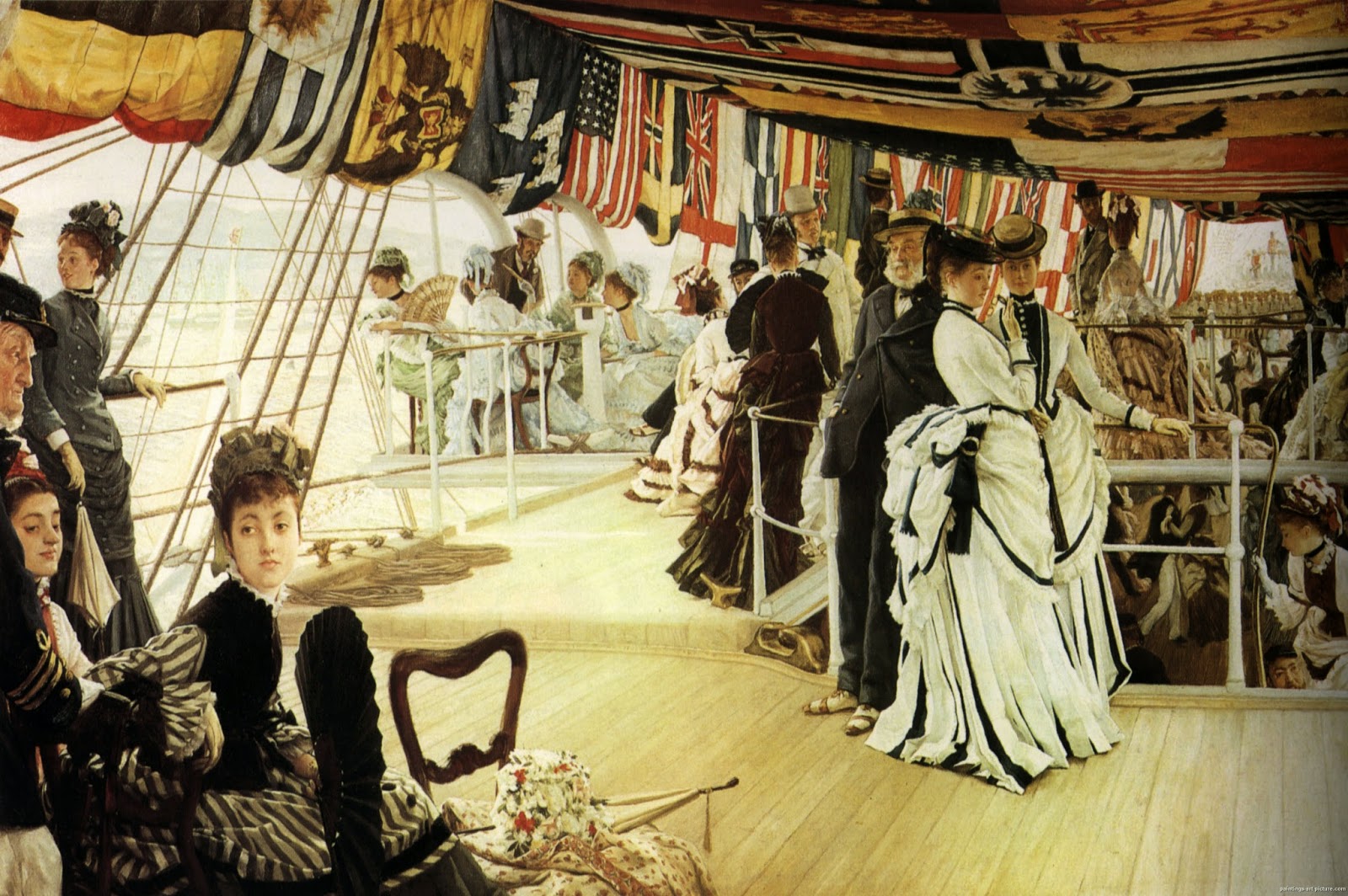 |
| The Ball on Shipboard 1874. Tate Gallery, London |
The Victorian period was a Gilded Age of extremes. At once there was untold industrial and scientific innovation that created vast Robber Baron wealth and an exploding bourgeois middle class. At the same time this industrial urban sprawl was creating a much larger inner city immigrant class, living in tenements, mining coal and working in factories. Child labor and worker safety laws were none existent. Typhoid, Cholera and disease ran rampant and crime and gang activity was commonplace to the millions of new city dwellers of the late 19th century. The new modern artists tried to depict the changing world of speed and smoke and poverty with new techniques and new ideas.
No one would ever suspect this was going on by looking at one of the great Victorian masters, James (Jacques Joseph) Tissot (1836-1902) Born and trained in France, Tissot studied at the Ecole de Beaux Arts and was close friends with Degas. In order to flee the Franco Prussian War he emigrated to England in 1871, where his fashionable and flattering paintings of English high society won him great acclaim and success.
 |
| The Reception 1885 |
Personally I have a double reaction to Tissot. As a painter I am mesmerized by the mastery of his craft of painting. As an artist I’m uneasy at the saccharine sweet depictions of the illusion (or delusion) of reality. The Barbie doll like depictions of women with their rosebud mouths, elongated fingers and tiny feet put me in a mind of Mannerist Disney princesses. The somnambulant figures languidly floating through their world is more surreal than any fantasy. He came to represent everything that the Modernists were fighting against. Despite this the paintings are enthralling in their detail. Reflections in silver teapots, the embroidery in silk tapestries, and his amber light filtering through chestnut leaves is unparalleled. In a time with only primitive photography, we can glimpse a technicolor high-def document of this lost world.
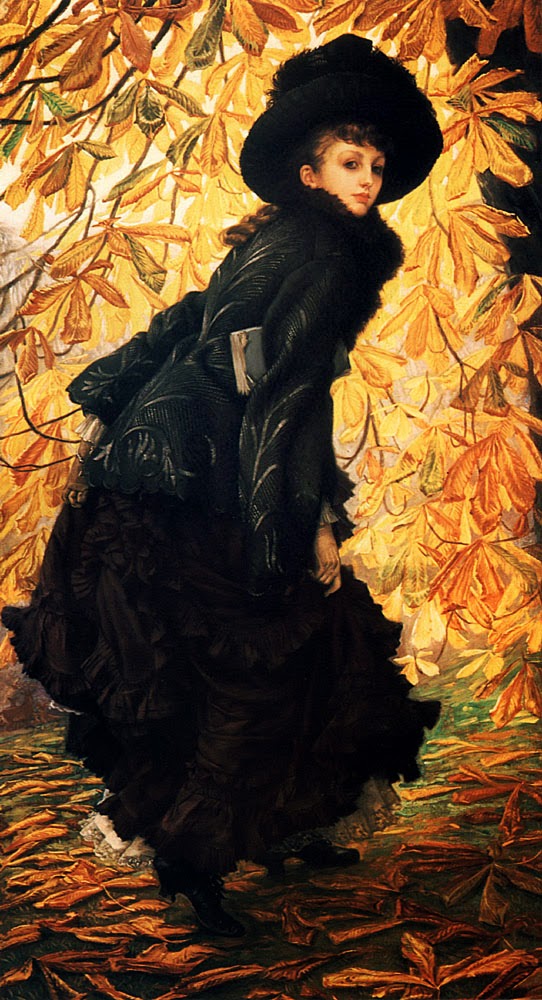 |
| October 1877 |
Later in Tissot’s career, as Modernism eclipsed the fashion for Victorian painting, he rediscovered his Catholic heritage and began a second career as an illustrator well renowned for his illustrating of the bible.
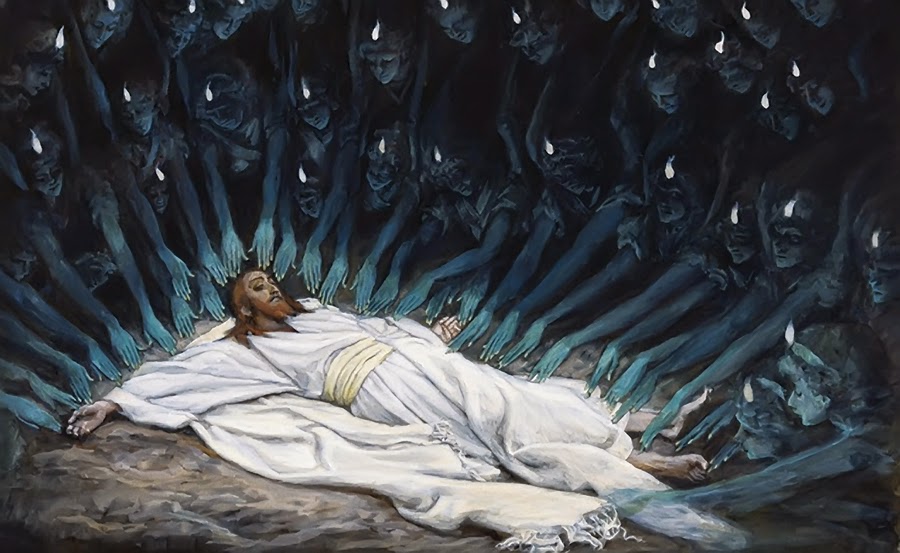 |
| And the Angels Ministered Unto Him 1895 |
Shunned for most of the 20th century today Tissot is having a renaissance, with many of the others of his contemporaries, not just for a new found appreciation for their craft, but as a sociological curiosity of a gilded age aesthetic that can never be replicated even amongst today’s top 1%.
Watch this wonderful opening scene of Martin Scorcese’s “Age of Innocence.” In it you will see the context of the way these paintings were originally displayed. I spy: Jean Leon Gerome, William Bouguereau, and James Tissot.
Many, many more of Tissot’s work can be found at the gallery on his Wikipedia page linked to above.
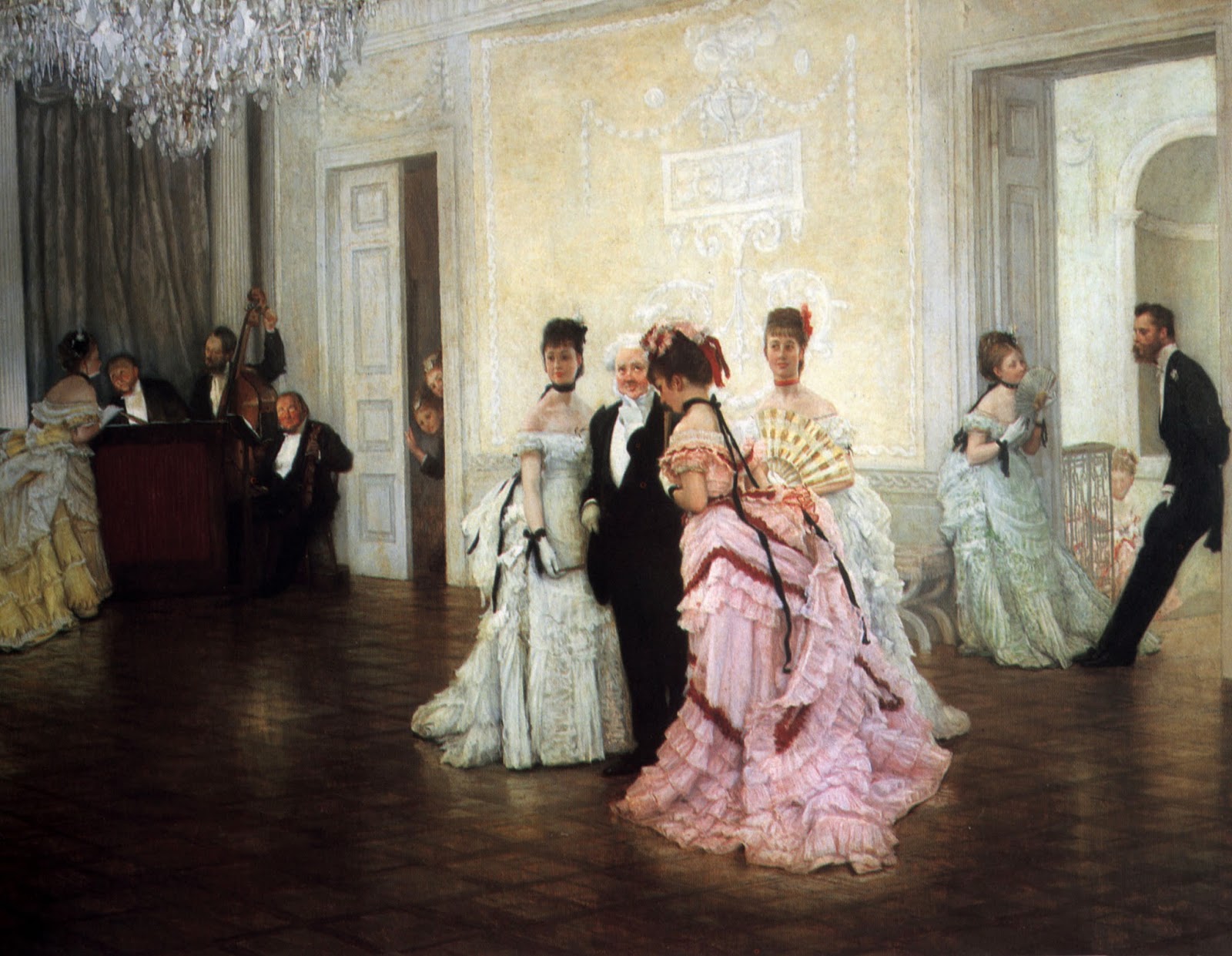 |
||||
| Too Early 1873 |
 |
| The Thames 1867
Enjoy: Go Forth and Learn.
WOC
|




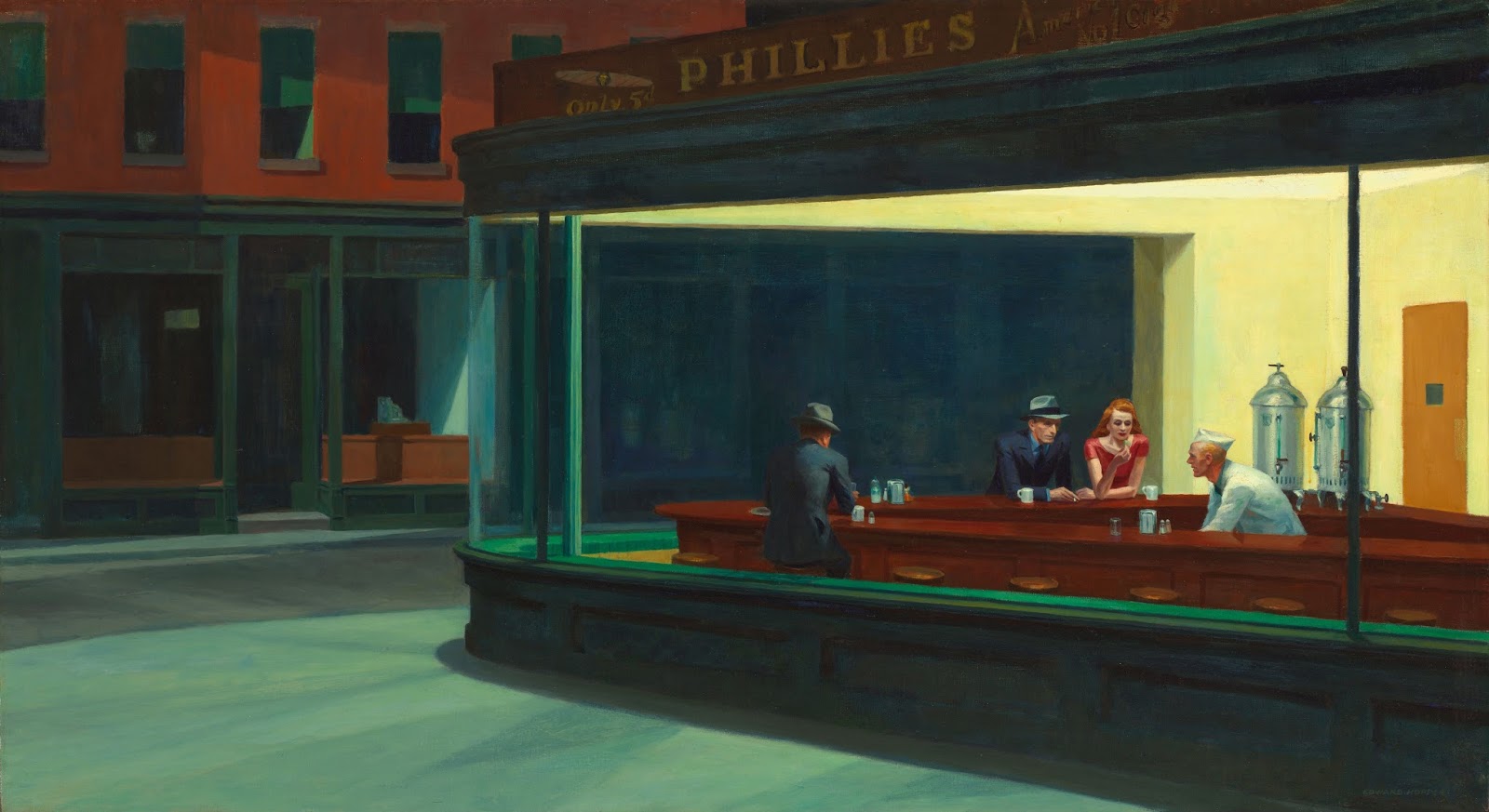
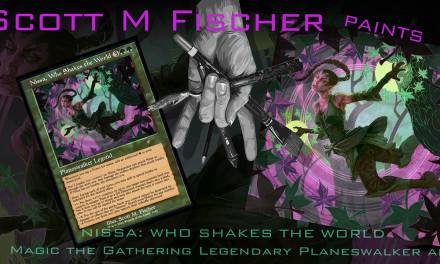

Oh i dunno. Yes, he paints them with aplomb and yes i could see how the subjects of his painting would be flattered but i think he wryly puts his sense of irony into the paintings. The Thames has folks more or less loafing amidst the bustling chaos of the new industry. The colors look dark, the Thames itself green and not particularly healthy, the man, unkempt and bored.
But it is the reception where i really sense his commentary. The young girl is obviously the center of attention. But her chaperone is faceless but we know his age from his hair. The gentlemen to the right, Statler and Waldorf, look to be discussing the old boy's plucking of the cradle. Monocle to the left seems envious as he's there with a languid ol' girl of a “proper” maturity. In light of these, even the young girl's expression takes on a forced cheerfulness. It's not easy being the trophy.
There is an art to insult when one's target does not even realize they are being insulted.
spelled mesmerized, I think.
And lovely experience you created, thank you.
what a picture very nice picture.i like your picture thank you for your post.welcome arisha
I can agree that he is often making very subtle hints to his audience, but they are so minor as to be non threatening. Its a tiny wink rather than an insult. I don't think any one would accuse Tissot of social commentary, like Wilde or Ibsen. But they are very beautiful.
I can agree that he is often making very subtle hints to his audience, but they are so minor as to be non threatening. Its a tiny wink rather than an insult. I don't think any one would accuse Tissot of social commentary, like Wilde or Ibsen. But they are very beautiful.
you are right-thanks- i fixed it.
you are right-thanks- i fixed it.
“The Thames” painting, I find very funny subtle commentary that here is this posh dandy and two girls blithly ignoring everything around them, as if they're punting on the Avon. Umbrellas up on a sunless afternoon, three bottles of champagne in the picnic basket, blissfully unaware of the world around them, even the dog is asleep! Rich kids with daddy's sports car.
“The Thames” painting, I find very funny subtle commentary that here is this posh dandy and two girls blithly ignoring everything around them, as if they're punting on the Avon. Umbrellas up on a sunless afternoon, three bottles of champagne in the picnic basket, blissfully unaware of the world around them, even the dog is asleep! Rich kids with daddy's sports car.
I found out about Tissot when I happened across an very good quality book of plates of his artwork… for £1 in a charity shop (thrift store). James Tissot, by Russel Ash, if anyone is interested in obtaining a second hand copy. (It is out of print, but second hand versions in good condition are fairly cheaply obtainable in the US, and even cheaper the UK.)
I was drawn to the book by the sheer beauty and skill of the artwork it contained. Looking at Tissot again, I can really see parallels between him, and the golden age of illustration he shortly preceded.
I would agree with your take on Tissot. I too like his work for the mastery of craft and as for the saccharine sweet depictions, well I just can't relate, even the nearest contemporary equivalent of rich pomp and circumstance, whatever that is these days I can't relate.
Although I will take exception with the Mannerist Disney princesses. OK, I'll give you the rosebud mouths, elongated fingers and tiny feet of the Disney characters too but Disney has always been good to its female's. With the exception of maybe Snow White they are always portrayed as strong women not weak feeble minded nymphs or vapid vain society trophies. Disney's are heroines of the story where Tissot's are pretty possessions.
There might be something of a commentary in the paintings if only a wink although I might think the subjects (of that day) would misinterpret or miss it. So far removed from the everyday life of the general population, much like celebrities of today, they were probably clueless enough to take it as some kind of compliment if they caught on at all.
I see in “The Thames” painting a smugness to the man (think living Kennedy's), It's HIS world and he enjoys showing off. Parade yourself and your trophies around for all lesser citizens to see otherwise whats the point of all that money. Look at his clean crisp trousers, white socks and even skin tones against the rest of the muddy colors, what a fantasy (sorry!… really!… no pun intended!). He is the only section of the painting portrayed that way.
Or maybe Tissot's intention was along those lines and the juxtaposition of the two concurrent worlds was enough by placing the smaller by percentage upper class (but larger in the composition) against the larger by percentage middle/lower class (smaller in the composition and shown only by the industry). Self importance.
Anyway, his mastery at designing compositions, especially the “The Ball on Shipboard”, “The Thames” among others is classic.
… I should have added… So I think there is something true to both scruffy's and your assessments.
“Kennedys”? lol Ever heard of the Romneys or the Bushes?
I had never seen “And the Angels Ministered Unto Him” It's so…mesmerizing. Those are some crazy cool angels.
Crazy cool indeed… I didn't realize they were the same artist until some research. That illo would stand up today as a magic card.
Crazy cool indeed… I didn't realize they were the same artist until some research. That illo would stand up today as a magic card.
I too was thinking of a contemporary analogy and came up with The Kardashians…if they're being made fun of, they don't care.
I too was thinking of a contemporary analogy and came up with The Kardashians…if they're being made fun of, they don't care.
When I was a student in the early ninties there was no internet, and no reproductions of the Victorians. I had to travel to London to view Tissot and Waterhouse and others at the Tate Gallery.
When I was a student in the early ninties there was no internet, and no reproductions of the Victorians. I had to travel to London to view Tissot and Waterhouse and others at the Tate Gallery.
…just happy somebody got the “Mannerist” reference.
…just happy somebody got the “Mannerist” reference.
Yeah, I was actually referring to the smugness or arrogance some rich and celebrities have and less of them being laughed at. For some reason it brought to mind Ted Kennedy and William Kennedy Smith.
As for the Age of Innocence clip, besides the artists you mentioned there's an Leon Bonnat at 1:38 (Madam Pasca), but the head is repainted for some reason (not so well). Bouguereau at 2:15 is not a highy quality print (as one would expect of such a high budget production) but a bad copy.